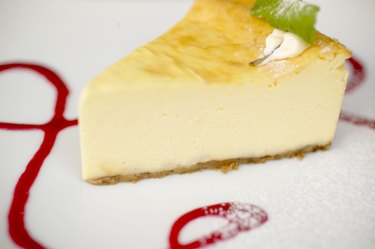
Cheesecake is one of those desserts that seems almost impossible. It is rich and creamy, yet firm enough to support a variety of toppings. Every home baker seems to have stories of failed, fallen or cracked cheesecakes. But this doesn't mean the perfect cheesecake can only be made in by a professional. Not at all. When you understand the science behind cheesecake, you can produce a reliably tall, creamy cheesecake in your kitchen every time.
The Science of Cheesecake
Video of the Day
Cheesecake is essentially a custard, or a thickened mixture of milk, sugar and eggs. The eggs are responsible for thickening the cheesecake, but they also add protein that coagulates at high heat, leading to cracks. A cheesecake that cracks too deeply will sink in the middle because there will not be enough structure to support its weight.
Video of the Day
Cheesecakes that completely cave in after baking and cooling are generally not cooked long enough to set the middle firmly. The outer edges may be fully cooked, but if the eggs in the center have not been fully cooked, their proteins will not coagulate enough to hold the center together, and it will fall as the cheesecake cools.
Temperature and coagulation are the key elements to control to produce a reliably creamy, firm cheesecake.
An Ounce of Prevention
Adding a small amount of cornstarch to the cream cheese before you beat it into the eggs and sweetened condensed milk helps ensure the eggs do not over coagulate, causing cracks. The starch coats the egg proteins, preventing them from tangling together.
Temperature control and baking technique are the keys to making sure the middle of your cheesecake is set without drying out the edges. Preheat your oven to 350 degrees Fahrenheit. Set the pan of cheesecake inside a larger roasting pan, then add about 1 inch of boiling water. Bake the cheesecake in the water bath for 45 minutes. Turn the oven off and let the cheesecake sit in the cooling oven for another hour. The water bath insulates the cheesecake from the dry heat of the oven, preventing the edges from drying out. Letting the cheesecake finish baking with residual heat in the oven as it gradually cools ensures the center is fully set and that it cools as slowly as possible, reducing the risk of collapse when you remove it from the oven.
Remove the cheesecake from the oven and let it cool to room temperature. Finally, refrigerate it for six hours or overnight to completely set the center.
When Cheesecake Cracks
If, despite your best efforts, your cheesecake develops small cracks on the top, it is not ruined. As long as the center is fully set, it should be able to withstand minor cracking. Simply cover the top of the cheesecake with whipped cream, fruit, chocolate ganache or another topping, and serve.
All Is Not Lost
If your cheesecake falls in the middle, the dessert is not completely ruined. Remove the cooled cheesecake from the pan and cut the salvageable portion into single serving squares. Top these with your favorite topping and serve them as a plated dessert or as cheesecake bites instead.